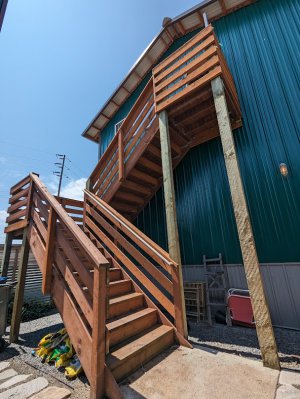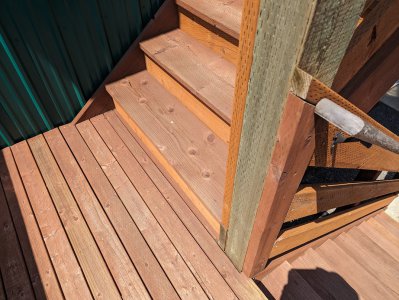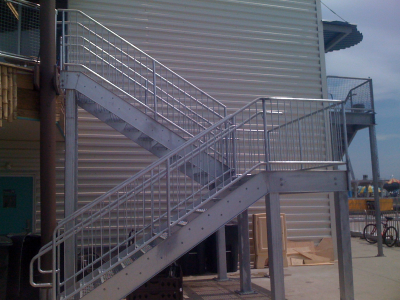- Joined
- Apr 23, 2018
- Messages
- 6,533
I built my shop to be two levels with 13' between decks, so I have a big outdoor staircase that didn't count against my square footage built outside rather than in.
I know very little about doing anything with wood. I think it is a terrible material, full of hard and soft spots, it warps, splits, and can't be welded. I act as if I have an allergy to cellulose, and only cut 2x4s when the world says I have to. I also have lived most of my life where it does not rain (California) or where it doesn't rain and nothing rots either (Nevada). I have been living in two different temperate rainforests that each get over 72" of rainfall per year, and my ineptitude with the inferior building material is starting to show. The stair treads are cupping, the planks are lifting, and all the stuff that used to fit together is moving apart. Nails are pulling up under the strain of warping wood.
Here's pics after 3 years. The pressure treated material is great, but the sun and moisture is causing it to twist, lift, and separate. Metal doesn't do that! I even think that my camera is fond of woodwork, since it didn't seem to pick up the number and severity of defects that I can observe from the same spots the pics were taken from. Things are starting to move, and the surface isn't holding up to treading on it.


I want to put some protection on this wood, but I'm nervous about not letting pressure treated breathe as it ages. I need to put something on the treads and decking to protect against the sun at minimum. What I don't want is to rebuild this staircase five years from now because I waited too long.
What should I use to ensure this staircase lasts as long as I do? Thompsons? I don't want whatever I apply to turn to s--t and have to re-do it every other year. I also don't like foot long splinters sticking out of the hand rails, so there has to be some way to preserve these tree bones. Please post your advice, experience, or just to profess your undying love for fir or pine. I feel I will regret not doing anything come winter.
I know very little about doing anything with wood. I think it is a terrible material, full of hard and soft spots, it warps, splits, and can't be welded. I act as if I have an allergy to cellulose, and only cut 2x4s when the world says I have to. I also have lived most of my life where it does not rain (California) or where it doesn't rain and nothing rots either (Nevada). I have been living in two different temperate rainforests that each get over 72" of rainfall per year, and my ineptitude with the inferior building material is starting to show. The stair treads are cupping, the planks are lifting, and all the stuff that used to fit together is moving apart. Nails are pulling up under the strain of warping wood.
Here's pics after 3 years. The pressure treated material is great, but the sun and moisture is causing it to twist, lift, and separate. Metal doesn't do that! I even think that my camera is fond of woodwork, since it didn't seem to pick up the number and severity of defects that I can observe from the same spots the pics were taken from. Things are starting to move, and the surface isn't holding up to treading on it.


I want to put some protection on this wood, but I'm nervous about not letting pressure treated breathe as it ages. I need to put something on the treads and decking to protect against the sun at minimum. What I don't want is to rebuild this staircase five years from now because I waited too long.
What should I use to ensure this staircase lasts as long as I do? Thompsons? I don't want whatever I apply to turn to s--t and have to re-do it every other year. I also don't like foot long splinters sticking out of the hand rails, so there has to be some way to preserve these tree bones. Please post your advice, experience, or just to profess your undying love for fir or pine. I feel I will regret not doing anything come winter.
Last edited:


